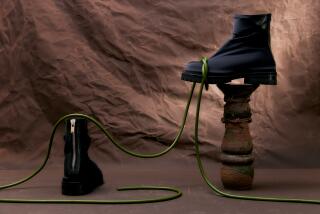Mazda Will Enter Luxury Market in ’94 With 2 Sedans : Autos: The U.S. market is crowded, and competition is expected to heat up. But the profits in selling expensive models are hard to resist.
- Share via
DETROIT — Less than two weeks after two European luxury car makers pulled out of the crowded U.S. market, Mazda Motor Corp. unveiled a new luxury division that will sell its pricey sedans in the United States beginning in 1994.
Pricing for the two proposed Amati sedans has not been set, but Richard Colliver, general manger of the Amati division, said the car would be competitive with other luxury Japanese models priced at $25,000 to $45,000.
Colliver said Amati, headquartered in Irvine, hopes to open 50 dealerships in areas that target upscale American consumers with family incomes of $75,000 or more. The cars, which will be built at a new plant near Mazda’s assembly factory in Hofu, Japan, will compete with Toyota’s Lexus, Nissan’s Infiniti and Honda’s Acura, as well as European luxury models.
With the new federal luxury tax, the recession and excess supply weakening sales and profitability, the luxury market has grown increasingly competitive. And as more auto makers enter the fray and those already in it expand their product lines, analysts say, the battle for customers in the luxury segment will continue to heat up.
“During the 1980s, there was very little price competition in the luxury segment,” said Susan Jacobs, an analyst with the Little Falls, N.J.-based consulting firm Jacobs Automotive, which specializes in luxury cars. “Now, everyone wants a piece of the pie.”
According to Jacobs, 20 nameplates have been introduced in the luxury segment since 1986. This year, Lexus, Infiniti and Acura are unveiling models, while General Motors Corp.’s Cadillac division, Ford Motor Co.’s Lincoln-Mercury division and BMW of North America are all bringing out new versions of key models.
Since Acura’s 1986 entry into the U.S. market, followed by Lexus and Infiniti in 1989, the Japanese auto makers have gained market share at the expense of the Big Three and the Europeans. In the first five months of this year, the Japanese market share increased to 31.8% from 23.5% while the Big Three’s share slipped to 49.7% from 59%.
Sterling Motor Cars and Peugeot S.A., two recent casualties of the fight for luxury market share, pulled out of the U.S. market earlier this month because they couldn’t sell enough vehicles. Sterling sales have fallen 28% so far in 1991, compared to the same period last year. Peugeot sales have fallen 17%.
“I think that was a good decision for them,” to leave the United States, Jacobs said. “They were small operators. There wasn’t any way they could come up with the kind of marketing money they needed. It was just too expensive for them (to compete) here.”
Fighting to regain its share, Cadillac has revamped its El Dorado and Seville to appeal to the younger generation that has largely deserted domestic makers for the Japanese. The main reason auto makers continue to forge into the dense and sometimes treacherous market is fairly simple: profits.
“You make a lot more money selling a $40,000 car than you do selling a $10,000 car,” said Christopher Cedergren, an automotive marketing consultant with AutoPacific Group in Santa Ana.
But the flip side of the auto makers’ quest for a higher profit margin--intense price competition--may be good news for consumers. As the volume of luxury cars grows to more than the market can handle, manufacturers are forced to offer cash incentives and low financing programs to attract customers. The level of incentives has already increased in the luxury market, and Jacobs expects incentives to become a more permanent feature of the luxury segment.
Despite the fierce competition, analysts don’t expect to see the ranks of luxury car makers significantly thinned soon. As the baby boom generation gets older and more affluent, analysts say, the market will continue to grow.
Before deciding to enter the tight luxury market, Mazda said it performed intensive research on every aspect of the new venture--including the name of the division, which company officials said comes from a Latin word for “to love.”
The name is meant to evoke such varied sensations as “the multicolored tapestry of a sunset,” “the delicate feel of fingertips on cashmere,” “the tartness of a ripe apple” and “the loving aroma of Thanksgiving turkey roasting in grandma’s oven,” according to company literature.
Whether customers will be able to discern all the subtleties embodied in the name will be seen, but analysts say translating the distinct image the company is aiming for in the nameplate into the product will be crucial to its success.
“All bets are on that the Amati nameplate will be successful,” says Cedergren. “The Japanese have a good track record, and we believe the luxury segment will continue to be one of the fastest-growing segments of the market.”
Chip Young, who owns a Mazda and Acura dealership in North Hollywood, agrees. Young and his brother plan to apply to be one of Amati’s 50 dealers in 1994.
“There are a lot of voices out there calling to the upscale customers, and whether Mazda can come in and make it remains to be seen,” Young said. “But we’re going to apply to get one of those franchises. We think it can be done.”
In the Lapse of Luxury
European car makers have lost a significant part of the luxury car market in the United States to the Japanese.
YEAR Big Three * Japanese ** European 1985 50.3% 0% 49.7% 1991 50.5% 19.3% 30.2%
* includes Cadillac, Lincoln and Imperial
** includes only Lexus, Acura and Infiniti nameplates
Source: Jacobs Automotive






